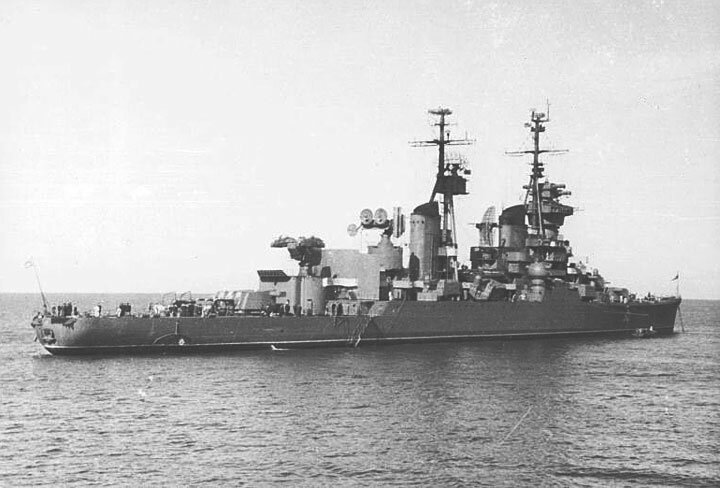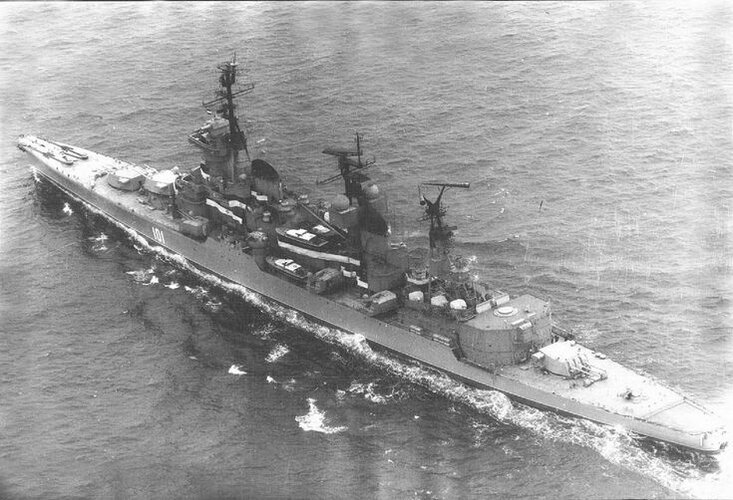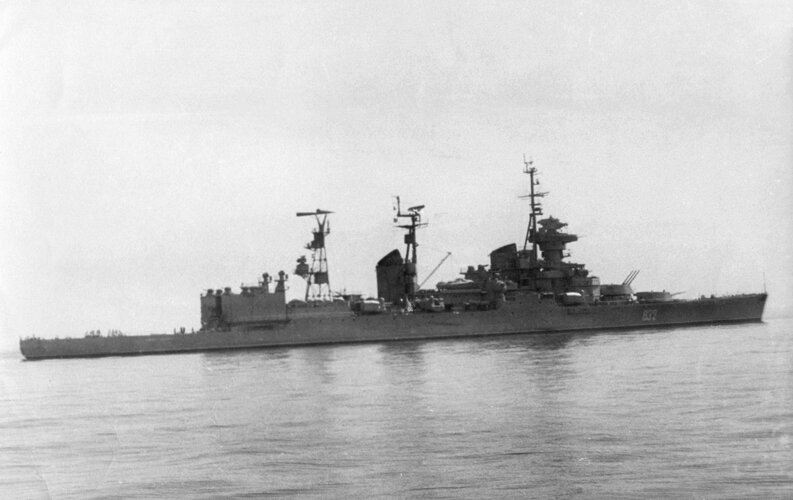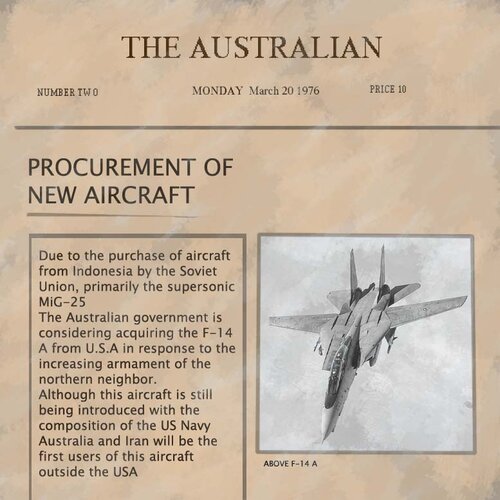Dilandu
I'm dissatisfied, which means, I exist.
So let's assume that Indonesian socialist leader Sukarno was more competent in terms of economic (or at least listened to better advisor) and managed to avoid the economy crisis that led to his downfall in OTL 1966. He remained relatively popular and in power; Indonesia remained socialistic and pro-Soviet. And Indonesian military continued to get new and better weapons from USSR; subsonic Tu-16KS bombers were replaced with supersonic Tu-22K. Mig-19 fighters gave way to Mig-23 and Mig-25 interceptors. Old gun-armed Project 30-bis destroyers were replaced with export-build Project 61 anti-submarine ships, equipped with state-of-art surface-to-air and anti-ship missiles.
For the Australia, dangerous times started. It have a constant source of threat now - and not somewhere far away, but just a few hundred kilometers to the north. Indonesian warships roamed Timor sea, locking their fire control radars on Australian shipping. Long-range jet bombers and patrol planes were reaching as far as Perth. High-altitude Mig-25R recon planes buzzed over Darwin, blatantly disregarding Australian air space.
What would Australia do in such situation? Of course, it need a better military than in OTL - the opponent it faced is close enough to be a direct threat to Australian mainland. What exactly Australia should seek to procure then?
P.S. To simplify the situation, let's assume that Indonesia have access to roughly the same level of Soviet-build hardware as Iraq. With a larger emphasis of navy, of course. I.e.:
AIR FORCE
* Mig-21, Mig-23MS as main fighters (about 200 units), Mig-25PD as interceptors (about 50 units), a small number of Mig-19 and Mig-17 as point-defense interceptors
* Mig-25RB as high-altitude fast recon & high-altitude strike planes (about 25 units)
* Tu-16K and Tu-22K as long-range bombers with KSR-2 and KSR-11 missiles (about 25 + 25 units)
* Su-17 and Mig-27 fighter-bombers as short-range attack planes (about 200 units)
NAVY
* Project 68bis cruiser (the "Irian", single units) - refitted replacement of X turret with one Osa-M self-defense SAM and four dual 57-mm AK- 725 autocannons
* Project 56BE missile destroyers (Kotlin-class, four units) - Project 56 destroyers, refitted with the replacement of rear turret with Volna-M SAM and forward turret with two 76-mm dual AK-726 autocannons. Torpedo banks replaced with four P-15/P-15M launchers
* Project 30BKM missile destroyers (six units) - Project 30-bis destroyers, refitted with the replacement of torpedo bunks with P-15/P-15M launchers and installation of a single ZIF-75 four-barrel 57-mm gun and three AK-230 30-mm autocannons
* Project 30K destroyers (two units) - non-modified Project 30-bis, used as training ships
* Project 159AE anti-submarine frigates (Petya-class, eight units) - increased anti-aircraft armament by replacement of rear 76-mm gun with Osa-M SAM & installation of additional AK-230 autocannons
* Project 50 anti-submarine frigates (Riga-class, six units in service) - increased anti-aircraft armament by installation of additional AK-230 autocannons
* Project 1234E missile corvettes (Nanuchka-class, eight units)
* Project 205 missile boats (Osa-class, eight units)
* Project 185R missile boats (Komar-class, eight units in service)
* Project 633 submarines (Romeo-class, six units)
* Project 613 submarines (Whiskey-class, six units in service, additional two used as training ships)
* Project 266 and Project 266M minsweepers (Yurka and Natya class, twelve units in total)
* Project 770 and Project 770M and Project 771 medium amphibious ships (Polnocny-class, Polish-build, twelve units)
* Naval patrol aviation have two squadrons, one of ten Il-38 patrol planes, the other of twelve Be-12 flying boats
* Naval strike aviations have two squadrons, one of Su-7UMK, the other of Su-20 fighter-bombers
* Naval fighter aviation have two squadrons of Mig-23MS fighters, modified for extended range (required over sea)
Procurement plans for 1980s include:
* Four Project 61ME OR four Project 956ME destroyers (the proposed, but never build export version of Project 956 destroyer, with 100-mm cannons, Volna-M SAM and P-15M missiles) - to replace the existing destoryer fleet
* Six Project 1159 light frigates (Koni-III class) - to replace the Project 159AE and Project 50 anti-submarine frigates
* Two-to-four Project 877E submarines, to replace the Project 613 and later Project 633 boats
* Negotiations are conducted with USSR and China about modernizing a pair of existing Project 633 submarines to surface-launch P-15M anti-ship missiles from deck-mounted containers
ARMY
* S-75, S-125 land-based SAM's, a limited number of S-200 long-range SAM's (export versions)
* Coastal missile batteries with P-15M missiles
* Army units mainly equipped with legacy Soviet era weapons, like T-34 and T-54 tanks, M-30 howitzers, BTR-50 APC's. Several elite reigments are equipped with newer weaponry, such as T-62 tanks, PT-76 light tanks, D-30 howitzers and mobile SAM systems.
For the Australia, dangerous times started. It have a constant source of threat now - and not somewhere far away, but just a few hundred kilometers to the north. Indonesian warships roamed Timor sea, locking their fire control radars on Australian shipping. Long-range jet bombers and patrol planes were reaching as far as Perth. High-altitude Mig-25R recon planes buzzed over Darwin, blatantly disregarding Australian air space.
What would Australia do in such situation? Of course, it need a better military than in OTL - the opponent it faced is close enough to be a direct threat to Australian mainland. What exactly Australia should seek to procure then?
P.S. To simplify the situation, let's assume that Indonesia have access to roughly the same level of Soviet-build hardware as Iraq. With a larger emphasis of navy, of course. I.e.:
AIR FORCE
* Mig-21, Mig-23MS as main fighters (about 200 units), Mig-25PD as interceptors (about 50 units), a small number of Mig-19 and Mig-17 as point-defense interceptors
* Mig-25RB as high-altitude fast recon & high-altitude strike planes (about 25 units)
* Tu-16K and Tu-22K as long-range bombers with KSR-2 and KSR-11 missiles (about 25 + 25 units)
* Su-17 and Mig-27 fighter-bombers as short-range attack planes (about 200 units)
NAVY
* Project 68bis cruiser (the "Irian", single units) - refitted replacement of X turret with one Osa-M self-defense SAM and four dual 57-mm AK- 725 autocannons
* Project 56BE missile destroyers (Kotlin-class, four units) - Project 56 destroyers, refitted with the replacement of rear turret with Volna-M SAM and forward turret with two 76-mm dual AK-726 autocannons. Torpedo banks replaced with four P-15/P-15M launchers
* Project 30BKM missile destroyers (six units) - Project 30-bis destroyers, refitted with the replacement of torpedo bunks with P-15/P-15M launchers and installation of a single ZIF-75 four-barrel 57-mm gun and three AK-230 30-mm autocannons
* Project 30K destroyers (two units) - non-modified Project 30-bis, used as training ships
* Project 159AE anti-submarine frigates (Petya-class, eight units) - increased anti-aircraft armament by replacement of rear 76-mm gun with Osa-M SAM & installation of additional AK-230 autocannons
* Project 50 anti-submarine frigates (Riga-class, six units in service) - increased anti-aircraft armament by installation of additional AK-230 autocannons
* Project 1234E missile corvettes (Nanuchka-class, eight units)
* Project 205 missile boats (Osa-class, eight units)
* Project 185R missile boats (Komar-class, eight units in service)
* Project 633 submarines (Romeo-class, six units)
* Project 613 submarines (Whiskey-class, six units in service, additional two used as training ships)
* Project 266 and Project 266M minsweepers (Yurka and Natya class, twelve units in total)
* Project 770 and Project 770M and Project 771 medium amphibious ships (Polnocny-class, Polish-build, twelve units)
* Naval patrol aviation have two squadrons, one of ten Il-38 patrol planes, the other of twelve Be-12 flying boats
* Naval strike aviations have two squadrons, one of Su-7UMK, the other of Su-20 fighter-bombers
* Naval fighter aviation have two squadrons of Mig-23MS fighters, modified for extended range (required over sea)
Procurement plans for 1980s include:
* Four Project 61ME OR four Project 956ME destroyers (the proposed, but never build export version of Project 956 destroyer, with 100-mm cannons, Volna-M SAM and P-15M missiles) - to replace the existing destoryer fleet
* Six Project 1159 light frigates (Koni-III class) - to replace the Project 159AE and Project 50 anti-submarine frigates
* Two-to-four Project 877E submarines, to replace the Project 613 and later Project 633 boats
* Negotiations are conducted with USSR and China about modernizing a pair of existing Project 633 submarines to surface-launch P-15M anti-ship missiles from deck-mounted containers
ARMY
* S-75, S-125 land-based SAM's, a limited number of S-200 long-range SAM's (export versions)
* Coastal missile batteries with P-15M missiles
* Army units mainly equipped with legacy Soviet era weapons, like T-34 and T-54 tanks, M-30 howitzers, BTR-50 APC's. Several elite reigments are equipped with newer weaponry, such as T-62 tanks, PT-76 light tanks, D-30 howitzers and mobile SAM systems.
Last edited:




